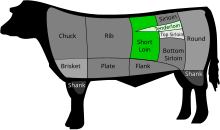T-bone steak
This article needs additional citations for verification. (February 2024) |
 Beef Cuts (American terminology) | |
| Type | Short loin and tenderloin cut of beef |
|---|---|
| Part of a series on |
| Steak |
|---|

The T-bone and porterhouse are steaks of beef cut from the short loin (called the sirloin in Commonwealth countries and Ireland). Both steaks include a T-shaped lumbar vertebra with sections of abdominal internal oblique muscle on each side. Porterhouse steaks are cut from the rear end of the short loin and thus include more tenderloin steak, along with (on the other side of the bone) a large strip steak. T-bone steaks are cut closer to the front, and contain a smaller section of tenderloin. The smaller portion of a T-bone, when sold alone, is known as a filet mignon (called fillet steak in Commonwealth countries and Ireland), especially if cut from the small forward end of the tenderloin.
Experts differ about how large the tenderloin must be to differentiate T-bone steak from porterhouse. The United States Department of Agriculture's Institutional Meat Purchase Specifications state that the tenderloin of a porterhouse must be at least 1.25 inches (32 mm) wide at its widest, while that of a T-bone must be at least 0.5 inches (13 mm) wide.[1]
Owing to their large size, and as they contain meat from two of the most prized cuts of beef (the short loin and the tenderloin), T-bone steaks are generally considered one of the highest quality steaks, and prices at steakhouses are accordingly high. Porterhouse steaks are even more highly valued owing to their larger tenderloin.
In British usage, followed in the Commonwealth countries, "porterhouse" often means a British sirloin steak (i.e. US strip steak) on the bone, i.e. without the tenderloin on the other side of T-bone. Some British on-line butchers also offer American style porterhouse steaks.
In New Zealand and Australia, a porterhouse is sirloin steak (strip steak in USA) off the bone.
The earliest mention of the term "porterhouse steak" in a newspaper appears to have been in a letter written by Thurlow Weed that appeared in the Hartford Courant on August 9, 1843, but the following year (August 24, 1844) it also appeared in a list of food prices in The New York Herald, and it appeared regularly in newspapers after that.
Anatomy of the T-bone
[edit]To cut a T-bone from butchered cattle, a lumbar vertebra is sawn in half through the vertebral column. The downward prong of the 'T' is a transverse process of the vertebra, and the flesh surrounding it is the spinal muscles. The small semicircle at the top of the 'T' is half of the vertebral foramen.
Preparation
[edit]
T-bone and porterhouse steaks are suited to fast, dry heat cooking methods, such as grilling or broiling. Since they contain a small amount of collagen relative to other cuts, longer cooking times are not necessary to tenderize the meat. There is some contention as to whether the bone conducts heat within the meat so that it cooks more evenly and prevents meat drying out and shrinking during cooking,[2][3] or the meat near the bone will cook more slowly than the rest of the steak,[4] and the tenderloin will tend to reach the desired temperature before the strip.[5][6]
Bistecca alla fiorentina
[edit]Bistecca alla fiorentina (lit. 'beefsteak Florentine style'), consists of a T-bone traditionally sourced from either the Chianina or Maremmana breeds of cattle. A favorite of Tuscan cuisine, the steak is grilled over a wood or charcoal fire, seasoned with salt, sometimes with black pepper, and olive oil, applied immediately after the meat is retired from the heat. Thickly cut and very large, "Bistecca" are often shared between two or more people, and traditionally served very rare, sometimes garnished with lemon wedges, if not accompanied by red wine, and accompanied by Tuscan beans as a side dish.[7]
Cotoletta alla milanese
[edit]The same cut of meat, but from a calf, is used for cotoletta alla milanese, which consists of 1.5 cm-thick cuts which are battered in breadcrumbs and fried in clarified butter with salt.
See also
[edit]References
[edit]- ^ United States Department of Agriculture (November 2014). Institutional Meat Purchase Specifications (PDF). Fresh Beef Series 100. p. 68. Archived (PDF) from the original on 21 December 2016. Retrieved 18 June 2021.
- ^ Delia Smith:Lamb Archived November 23, 2010, at the Wayback Machine
- ^ LBC:Cooking in the credit crunch Archived 2011-07-27 at the Wayback Machine
- ^ "Buy T Bone Steak | T-Bone Steak for Sale UK". Eat Great Meat. 30 March 2018. Retrieved 2020-08-14.
- ^ King (Née Turner), Nicola J.; Whyte, Rosemary (2006). "Does It Look Cooked? A Review of Factors That Influence Cooked Meat Color". Journal of Food Science. 71 (4): R31–R40. CiteSeerX 10.1.1.668.6042. doi:10.1111/j.1750-3841.2006.00029.x.
- ^ Serious Eats (30 May 2014). "How to Grill a T-Bone Steak". Archived from the original on 4 March 2016. Retrieved 5 March 2016.
- ^ Waverly Root, The Food of Italy, 1971, ISBN 0-394-72429-1.
External links
[edit]- "USDA Institutional Meat Purchase Specifications". Archived from the original on 2014-08-06. Retrieved 2022-03-10. (687 KiB)
- "Beef Cuts Chart" (PDF). Archived from the original (PDF) on 2013-05-03. Retrieved 2011-12-12.
- Porter House name origin article


